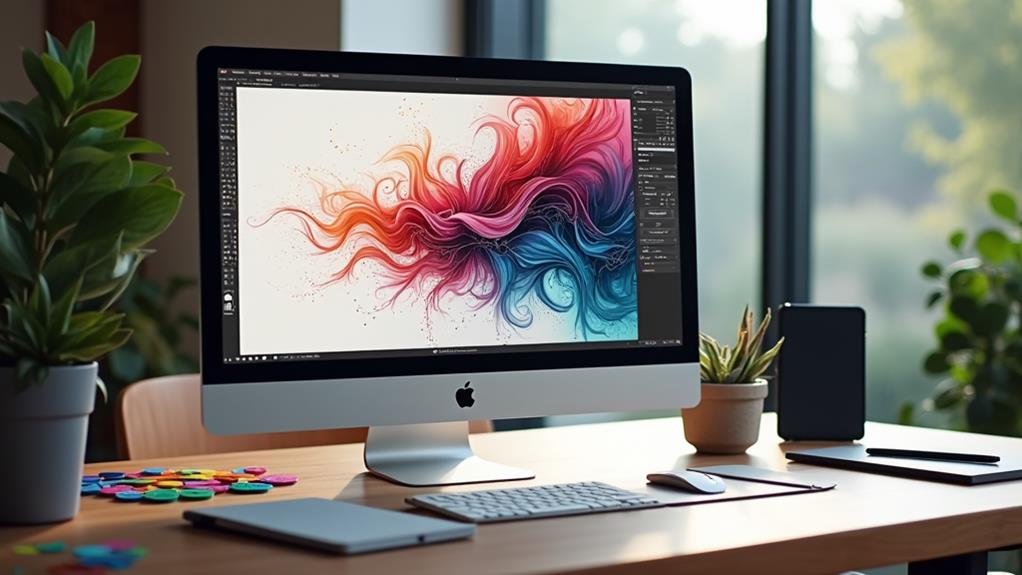
Digital product creators must leverage top-tier graphic design tools to craft compelling visuals. Adobe Illustrator is indispensable for advanced vector graphics, while Canva offers user-friendly, professional templates suited for beginners. GIMP and Inkscape provide powerful, free alternatives to premium software, ideal for detailed editing and scalability. For quick photo edits, Pixlr thrives with its intuitive interface and robust toolset. Essential features like cross-platform compatibility, file format support, and customizable templates enhance these tools' versatility. By mastering these applications, designers can boost their creativity and efficiency considerably, ensuring high-impact results for various digital products. Discover more insights and practical tips ahead.
Key Takeaways
- Canva: User-friendly design tool ideal for creating social media graphics and marketing materials with customizable templates and real-time collaboration.
- Adobe Express: Offers easy-to-use AI-powered design tools, perfect for high-quality marketing materials without a steep learning curve.
- GIMP: Free, advanced editing software with customizable interface and extensive plugin library, great for professional-grade visuals.
- Inkscape: Open-source vector graphics editor with a comprehensive toolkit, supporting multiple platforms and scalable formats.
- Pixlr: Versatile photo editing tool with an intuitive interface and essential editing features, supporting multiple file formats for diverse projects.
Importance of Graphic Design Software
The significance of graphic design software cannot be overstated in the domain of digital product creation. In an era where first impressions are formed in just 0.05 seconds, the ability to produce compelling visuals is vital. Effective graphic design software enables creators to tap into current graphic trends and craft engaging visual storytelling that captures attention within the essential 2.6-second focus window users typically allocate to specific areas of a website.
To maintain visual relevance, designers should stay updated on the latest trends and incorporate user feedback for continuous improvement.
Aesthetic appeal is not merely an accessory; it is a cornerstone of brand differentiation. High-quality graphic design can boost a brand above its competitors, making it indispensable in crowded marketplaces. For small and medium-sized businesses with limited budgets, free graphic design software options can be particularly valuable. These tools provide fundamental functionalities that empower businesses to produce professional-grade visuals without incurring significant financial burdens.
Moreover, the functionality of graphic design software must align with the user's skill level. Matching the right tools with the user's capabilities guarantees ideal results, allowing both novices and experts to create visually striking content effectively.
Choosing the Right Software
Selecting the ideal graphic design software demands a strategic approach tailored to individual needs and expertise levels. When evaluating options, it is essential to analyze the software's alignment with your current skill set.
Beginners might find user-friendly platforms like Canva or Snappa advantageous, while those with advanced skills may prefer robust tools such as GIMP or Adobe Illustrator. For those focused on creating scalable vector graphics, Adobe Illustrator is often the go-to choice due to its versatility and professional outcomes.
Consider the specific requirements of your digital product. For instance, vector graphics are fundamental for logos, whereas high-quality photo editing is imperative for marketing materials. Confirming the software supports necessary file types and functionalities is critical to achieving professional results.
Additionally, the ability to access the software across different platforms (PC, Mac, mobile) can enhance collaborative efforts and streamline workflows. User feedback and emerging design trends should also guide your decision.
Software that offers extensive template libraries can save valuable time and fuel creativity, a significant benefit for projects like ebooks and social media graphics. Cost is another factor—balancing subscription fees against one-time purchases can be essential for startups and small businesses.
- Evaluate your skill level and software complexity
- Confirm platform accessibility for seamless collaboration
- Analyze cost-effectiveness for budget constraints
Software for Different Skill Levels
When commencing on the journey of graphic design, choosing software that matches your skill level can greatly influence your creative outcomes and workflow efficiency.
For novices, beginner tools like Canva and Snappa are invaluable. These platforms offer extensive templates and intuitive drag-and-drop interfaces, making it easy to produce polished designs swiftly. Their user-friendly nature guarantees that even those with no prior design experience can achieve professional-looking results.
Beginners can also benefit from code-free solutions like Webflow, which offers easy animation and interaction capabilities.
Intermediate users might find a more fitting match in software such as Gravit Designer and Adobe Express. These tools strike a harmonious balance between simplicity and functionality, providing essential features alongside customization options. This allows for the execution of more complex design tasks without overwhelming the user, thereby fostering a seamless shift from basic to more sophisticated design projects.
On the other end of the spectrum, advanced users demand software with powerful editing capabilities and extensive toolsets.
GIMP and Adobe Illustrator stand out in this regard. These platforms are replete with advanced features that cater to intricate, professional design needs.
In addition, software like Figma and Inkscape, with their wide-ranging functionalities and steeper learning curves, are best suited for those with substantial design experience, ready to tackle detailed and nuanced projects.
Software for Various Use Cases
Having explored software tailored for different skill levels, it is equally important to recognize that the tools chosen should align with the specific use cases intended by digital product creators. Various software options cater to distinct needs, from crafting digital branding to developing extensive online courses.
Understanding the importance of user experience in design can greatly influence the choice of tools, ensuring they meet both functional and aesthetic standards.
For those focused on digital branding and marketing visuals, Canva stands out with its intuitive interface and extensive library of templates. It is particularly useful for creating engaging social media graphics and marketing materials, streamlining the design process for both novice and experienced designers.
Educators and course creators may find Thinkific indispensable. This platform provides an all-encompassing environment for developing, hosting, and selling online courses. Its multimedia support and drag-and-drop builder simplify content creation, making it an excellent choice for educators aiming to disseminate knowledge digitally.
Digital product creators looking to monetize their work can leverage Gumroad. This platform facilitates the direct sale of digital products such as ebooks and templates, complemented by built-in marketing tools that enhance the sales process.
- Canva: Ideal for social media graphics and marketing materials.
- Thinkific: Extensive platform for creating and selling online courses.
- Gumroad: Simplifies the sale of digital products with integrated marketing tools.
Each tool addresses unique aspects of digital creation, ensuring that creators can effectively meet their specific needs.
Essential Features to Consider
When selecting graphic design tools, prioritizing a user-friendly interface is paramount to streamline the creative process and boost productivity.
Equally critical is ensuring the software supports a wide range of file formats, such as PNG, JPEG, and SVG, enabling seamless integration across various digital platforms.
Additionally, this flexibility helps in diversifying services offered to clients, which can broaden the client base and increase earnings.
These features together empower digital product creators to produce and share high-quality work effortlessly.
User Interface Design
Creating an effective user interface (UI) for design software is paramount, as it directly influences the user's ability to navigate and utilize the tool efficiently. Adopting the latest user interface trends, such as intuitive navigation and drag-and-drop functionality, can considerably reduce the learning curve, making the software accessible to users of all skill levels.
Clear organization of tools and features, categorized appropriately, enhances workflow efficiency, enabling users to quickly locate design assets and options. Incorporating customizable templates within the UI streamlines the creation process. These templates allow designers to produce professional-quality visuals without having to start from scratch, thereby saving time and effort.
Additionally, responsive design elements guarantee that the software adapts seamlessly to various screen sizes and formats, which is essential for creating versatile graphics suitable for multiple platforms.
Essential features to take into account in UI design for graphic tools include:
- Drag-and-Drop Functionality: Enhances usability by allowing users to manipulate design elements effortlessly.
- Customizable Templates: Streamline the design process, enabling quick production of high-quality visuals.
- Responsive Design Tools: Ensure adaptability to different screen sizes, enhancing cross-platform compatibility.
File Type Compatibility
For digital product creators, ensuring robust file type compatibility within graphic design tools is essential. Modern design software must support a plethora of file types, including PNG, JPEG, SVG, and PDF, to offer versatility and seamless integration across various platforms and applications. This broad compatibility is critical to adapt to current file format trends and maintain the visual integrity of digital products.
A significant aspect of graphic design software evolution is the ability to export images without quality loss. Formats like PNG are necessary for graphics, while JPEG is preferable for photographs, ensuring that the visual fidelity remains intact.
Vector file formats, such as SVG and AI, are irreplaceable as they allow scalability without any degradation in quality, making them perfect for logos and illustrations.
Furthermore, the capability to resize images without compromising quality is essential for adapting designs to diverse digital product specifications. Efficient file size management and optimization features are equally important, ensuring quick loading times and maximum performance in digital environments.
As file format trends continue to evolve, leveraging design software that adapts to these changes will be a cornerstone of successful digital product creation.
Testing and Evaluating Tools
To effectively test and evaluate graphic design tools, it is essential to conduct practical usability tests on common projects such as logo designs and social media graphics.
Emphasize key criteria like ease of element manipulation, template quality, and software compatibility with various file types and sizes to guarantee high professional standards.
Comparing these features against specific business needs will provide a thorough understanding of each tool's capabilities and limitations.
Utilizing affordable design tools like Figma and Webflow can streamline the evaluation process, allowing for efficient and cost-effective assessments.
Key Evaluation Criteria
When selecting graphic design tools for digital product creation, a multitude of key evaluation criteria must be meticulously considered to guarantee peak performance and usability.
Central to this process is evaluating the intuitiveness of the interface, which directly impacts design efficiency. A user-friendly design tool reduces the learning curve, allowing designers to focus on creative tasks rather than maneuvering through complex software functionalities.
Beyond the interface, it's essential to assess the software's compatibility with various file formats. Ensuring the tool supports a wide array of formats like PNG and JPEG is fundamental for meeting diverse design needs and facilitating seamless exporting and sharing of finished products.
Additionally, the availability of templates and customization options plays a significant role. Extensive libraries of pre-designed templates can streamline the design process, enabling designers to save valuable time on repetitive tasks and focus on innovative aspects of their projects.
To encapsulate the key evaluation criteria:
- Intuitive Interface: Simplifies the learning curve, enhancing design efficiency.
- File Format Compatibility: Important for diverse design and seamless sharing.
- Templates and Customization: Streamlines workflow, boosting creativity and productivity.
Practical Usability Tests
Evaluating the practical usability of graphic design tools is paramount for ensuring they meet the rigorous demands of digital product creators. Usability tests should be conducted with a focus on the ease of navigation and intuitive design features, which are essential for both novice and seasoned designers.
These tests should encompass the software's ability to handle routine tasks such as image resizing without quality loss and background removal, key for creating polished digital products.
A critical component of these evaluations is the versatility and quality of available templates. Extensive template libraries can streamline the creative process, enabling designers to produce high-quality eBooks or social media graphics efficiently.
Equally important is the assessment of collaboration features found in tools like Figma and Lunacy. These features should facilitate seamless teamwork and real-time editing, enhancing productivity and cohesion among design teams.
Throughout the testing phases, gathering user feedback is indispensable. This feedback highlights the software's strengths and uncovers areas for improvement, ensuring that the tools evolve in line with user needs.
Feature Comparison Metrics
Evaluating the efficacy of graphic design tools requires a multidimensional approach, integrating expert insights with technical precision to establish robust feature comparison metrics.
Testing these tools involves scrutinizing their ease of use, especially for non-designers, guaranteeing that even novices can swiftly learn and deploy features in practical projects.
Performance metrics are indispensable; they encompass the software's capability to manage diverse file types and sizes, and the integrity of image exports when resizing to prevent quality degradation.
The availability of extensive template variety is essential. Rich template libraries can dramatically reduce design time and spark creativity, enabling users to efficiently craft digital products.
Equally important are collaboration tools, particularly within cloud-based platforms. These tools facilitate seamless real-time feedback and sharing among team members, enhancing productivity and coherence in design processes.
User feedback is paramount in this evaluative process, offering invaluable insights into the strengths and shortcomings of the tools based on actual usage experiences.
Key metrics to evaluate include:
- Ease of use: Particularly critical for non-designers.
- Performance: Handling of various file types and sizes, quality of exports.
- Collaboration tools: Real-time feedback and teamwork capabilities.
Incorporating these metrics guarantees a thorough and precise evaluation of graphic design tools.
Overview of Top Tools

Maneuvering the landscape of graphic design tools can greatly enhance the efficiency and creativity of digital product creators. Canva stands out with its user-friendly interface and an extensive library of templates and design assets, perfect for quick and polished content creation like eBooks and social media graphics.
By staying abreast of design trends, Canva guarantees that users have access to contemporary styles and elements. Its software integrations with platforms like Google Drive and Dropbox further streamline the design process, making it a go-to tool for many creators. Engaging with followers on social media platforms can considerably increase reach and visibility for creators using Canva.
Adobe Express offers a suite of easy-to-use design tools complemented by free AI features, enabling creators to produce visually appealing marketing and branding materials with precision. Its robust capabilities make it a staple for professionals seeking high-quality results without a steep learning curve.
Thinkific excels as a thorough platform for creating and selling online courses, offering multimedia support and a drag-and-drop builder to simplify course creation.
Gumroad provides an intuitive solution for selling digital products directly to consumers, equipped with built-in marketing tools that aid in product promotion and sales tracking.
Lastly, Notion serves as an indispensable productivity app, ideal for organizing content plans and creating knowledge bases, particularly valuable for course creators and template designers.
DesignWizard
As digital product creators explore the myriad of graphic design tools available, DesignWizard emerges as a remarkable contender, particularly for those seeking quick and efficient design solutions. With a substantial database of images and over 10,000 free templates, DesignWizard stands out as a valuable resource.
The platform's user-friendly interface empowers users to create professional-grade designs without requiring extensive graphic design experience, making it an accessible tool for novices and experts alike. For those looking to enhance visual appeal in their portfolios, DesignWizard provides various customizable options that can greatly improve the presentation of work samples.
One of DesignWizard's standout features is its extensive library of customizable templates. This not only saves time but also enhances workflow efficiency by providing ready-made options tailored to various design needs.
However, it is worth noting that the free version of DesignWizard has limited search functionality, which may necessitate more manual navigation through templates.
DesignWizard supports various file formats, ensuring seamless compatibility for digital products across different platforms. This flexibility is vital for creators who need to deliver their designs in multiple formats for diverse applications.
- Key benefits of DesignWizard:
- Extensive library of over 10,000 free templates
- User-friendly interface for efficient design creation
- Supports various file formats for broad compatibility
Canva

In the domain of graphic design tools, Canva stands out like a Swiss Army knife for digital product creators, offering an extensive suite of features designed to streamline the creative process. Its user-friendly drag-and-drop interface guarantees that even novices can produce visually compelling graphics swiftly and efficiently.
With access to over 250,000 free Canva templates and millions of images, users can tailor their designs for a myriad of digital products such as social media posts, ebooks, and marketing materials.
The platform excels in its Canva collaboration capabilities, allowing teams to collaborate in real-time, an essential feature for projects requiring input from multiple stakeholders. Canva also enhances workflow efficiency by integrating with social media platforms, which facilitates seamless sharing and scheduling. This is especially beneficial for those who excel as a freelance social media manager, guaranteeing timely and engaging content distribution.
Additionally, users can export their designs in various formats, including PNG, JPEG, and PDF, guaranteeing high-quality visuals for both digital and print media.
Canva's ongoing updates and tutorials further enrich its offerings, making it continually more accessible and user-friendly. Whether you're concerned with Canva pricing or seeking advanced Canva branding options, this versatile tool has something for everyone, solidifying its place as an indispensable asset in the arsenal of digital product creators.
GIMP
GIMP, an epitome of versatility in the domain of graphic design, offers digital product creators a potent and free alternative to premium software. As an open-source powerhouse, GIMP (GNU Image Manipulation Program) supports a myriad of file formats, including PNG, JPEG, and TIFF, making it a versatile tool for diverse digital creations.
Its advanced editing capabilities, such as layers, masks, and filters, enable users to execute complex image manipulation tasks comparable to those found in Adobe Photoshop. Additionally, GIMP's powerful features align well with analyzing performance metrics to understand user engagement and improve digital product design.
One of GIMP's standout features is its compatibility with multiple operating systems—Windows, macOS, and Linux—ensuring broad accessibility. The software's customizable interface and an extensive range of GIMP plugins allow users to tailor their workspace and extend functionality to meet specific design needs.
Although GIMP has a steep learning curve, the availability of numerous GIMP tutorials and an active GIMP community provides essential support for beginners and advanced users alike.
- Customizable Interface: Tailor your workspace for efficient design.
- Comprehensive Tutorials: Access a wealth of GIMP tutorials to master the software.
- Extensive Plugin Library: Enhance functionality with a wide array of GIMP plugins.
For those seeking GIMP alternatives, the software's robust features and supportive community make it a compelling choice.
Inkscape

A beacon of precision in the domain of vector graphics, Inkscape empowers digital product creators with an extensive suite of tools designed to enhance their design projects. As a powerful open-source vector graphics editor, Inkscape supports a myriad of file formats, offering unmatched versatility for diverse design needs.
Its thorough toolkit includes bezier curves, shapes, and text manipulation, ensuring designers can craft intricate and polished graphics with ease. Inkscape is like NASM certification for graphic designers, providing credibility and expertise in the field.
Inkscape's compatibility across Windows, macOS, and Linux platforms considerably broadens its accessibility, making it a go-to choice for digital artists worldwide. The robust Inkscape community stands as a proof of its enduring appeal, providing a wealth of Inkscape tutorials, forums, and resources that foster continuous learning and skill enhancement.
Additionally, the availability of numerous Inkscape plugins allows users to extend the software's functionality, tailoring it to their specific project requirements.
One of Inkscape's standout features is its highly customizable user interface, which, despite its initial complexity, can be adapted to suit both novice and experienced users. The introduction of Inkscape shortcuts and regular Inkscape updates further streamline workflow efficiency, ensuring that designers can focus on their creativity without constraints.
Pixlr
Pixlr stands out as a free, versatile photo editing tool, catering to both novices and seasoned designers with its extensive range of features.
Its intuitive drag-and-drop interface facilitates effortless image editing, while support for multiple file formats like JPEG, PNG, and PSD guarantees seamless integration with various sources.
With essential tools such as filters, effects, and layers, Pixlr empowers users to produce professional-quality graphics, even on mobile devices.
Key Features Overview
Delving into the core functionalities of Pixlr reveals a robust suite of tools designed to cater to both novice and experienced digital product creators. This versatile platform excels by offering a free online photo editing tool that seamlessly bridges basic and advanced editing capabilities.
With support for a wide array of file formats, including JPEG, PNG, and BMP, Pixlr guarantees that users can manage and manipulate various image types efficiently.
One of Pixlr's standout features is its advanced editing options, which include AI-powered tools for background removal and image enhancement. These intelligent features greatly streamline the design process, enabling creators to achieve professional-quality results with minimal effort.
Moreover, Pixlr's mobile accessibility is a game-changer, allowing users to edit images on-the-go via its dedicated mobile app, providing flexibility and convenience across different devices.
Additionally, Pixlr boasts an intuitive user-friendly interface, characterized by its drag-and-drop functionality. This makes it easy for users to quickly and effortlessly manipulate design elements, enhancing overall productivity.
- Advanced editing tools: AI-powered background removal and image enhancement.
- Mobile accessibility: Seamless editing on-the-go with the Pixlr mobile app.
- Wide file format support: Compatible with JPEG, PNG, BMP, and more.
Pixlr's key features collectively make it an indispensable tool for digital product creators seeking efficiency and precision in their design workflows.
Ease of Use
Maneuvering through Pixlr's interface reveals a thoughtfully designed platform that prioritizes user experience, ensuring photo editing remains both intuitive and efficient. User feedback consistently highlights Pixlr's straightforward drag-and-drop functionality, which simplifies the process of uploading images and manipulating design elements.
This feature is particularly beneficial for those new to graphic design, as it minimizes the learning curve without sacrificing the tool's robust capabilities appreciated by seasoned designers.
Pixlr excels in its provision of a variety of templates and preset filters, aligning with current design trends and enabling rapid content creation. This is especially advantageous for digital product creators who require quick turnarounds for social media visuals and other digital content.
The platform supports multiple file formats, including JPEG and PNG, providing the versatility needed for diverse design projects.
The cloud-based nature of Pixlr enhances its usability, allowing users to access and edit their projects from any device with internet connectivity. This flexibility is essential for digital product creators who are often on the go and need consistent access to their design tools.
Frequently Asked Questions
What Is the Best Software for Digital Design?
The best software for digital design varies by project needs and user proficiency. Adobe Creative Cloud leads design software trends, offering advanced digital design techniques, while Figma excels in collaboration, and Canva simplifies quick, template-based creations.
Is a Digital Creator a Graphic Designer?
A digital creator is not inherently a graphic designer. While digital creator skills often encompass some graphic design roles, professional graphic designers possess specialized training in design principles, software proficiency, and a deep understanding of visual communication.
What Are the Best Tools for Graphic Designers?
The best tools for graphic designers include Adobe Photoshop, Adobe Illustrator, Canva, Affinity Designer, and Figma. These tools align with current design trends and enhance workflow efficiency through advanced features, collaborative capabilities, and user-friendly interfaces.
What Kinds of Software Can Be Used to Make a Digital Graphic?
Software for creating digital graphics includes Adobe Illustrator for vector illustration, Adobe Photoshop for digital painting, and open-source options like GIMP and Inkscape for extensive editing capabilities, catering to both professional and amateur designers.
Conclusion
In summation, selecting the appropriate graphic design software is paramount for digital product creators, as it influences both the creative process and the final output. By considering skill levels, specific use cases, and essential features, creators can optimize their workflow and enhance their design quality. Tools such as Canva, GIMP, Inkscape, and Pixlr offer varied functionalities catering to diverse needs, thereby empowering creators to achieve professional-grade results efficiently and effectively.
Leave a Reply